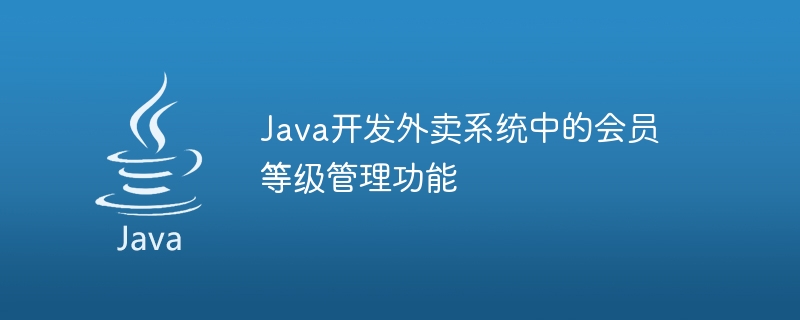Home >Java >javaTutorial >Java develops membership level management function in takeout system
Java develops membership level management function in takeout system
- WBOYWBOYWBOYWBOYWBOYWBOYWBOYWBOYWBOYWBOYWBOYWBOYWBOriginal
- 2023-11-01 13:19:45852browse

Java develops membership level management function in takeout system
With the rapid development of the mobile Internet, the takeout industry is gradually rising in the Chinese market. As an important part of people's lives, the increasingly perfect and convenient takeout system has become the goal of pursuing user experience. Among them, the membership level management function is an important part of the takeout system, which can provide users with more discounts and services, and can also effectively promote users' consumption willingness and loyalty.
As a mature and powerful programming language, Java plays an important role in the development of takeout systems. Its powerful functions and flexibility make Java the preferred language for developing takeout systems. As one of the core functions in the takeout system, the membership level management function needs to be implemented with the help of Java.
First of all, the membership level management function needs to realize the user's point accumulation and level improvement. Through the object-oriented features of the Java language, a user class can be created to manage user information and status. The user category can include basic information such as user ID, user name, password, mobile phone number, etc., as well as the user's points and levels. When users place orders, comment, pay, etc., code written in Java can be used to increase or decrease the user's points. When a user's points reach a certain value, they will be automatically upgraded to a higher level; conversely, users who have insufficient points or have been inactive for a long time will be downgraded. Through code written in Java, user level monitoring and adjustment can be achieved.
Secondly, the membership level management function also needs to provide corresponding discounts and services. Using Java's multi-thread processing capabilities, asynchronous tasks can be executed, thereby refreshing membership levels and issuing corresponding discounts. For example, after the user places an order and the payment is completed, the Java code can refresh the user's level through asynchronous tasks and give them corresponding coupons or points as rewards. This method will make the user experience smoother, and the user's operations will no longer be blocked by task execution, improving user satisfaction.
In addition, the membership level management function also needs to provide the display and change of user levels. Through code written in Java, user-level display and display mode customization can be achieved. For example, user levels and corresponding benefits can be displayed on the personal center page, and users can check their levels and benefits at any time. In addition, when users need to apply for a higher-level membership, Java code can also implement user level changes and reviews, and notify the user of the review results via email or text message. This approach can increase user engagement and loyalty.
To sum up, the membership level management function in Java development of takeout system is extremely important. Through the advantages of Java, users can accumulate points and upgrade their levels, and provide users with corresponding discounts and services. At the same time, it can also display and change user levels to improve user participation and loyalty. In the competition of food delivery systems, the optimization and improvement of membership level management functions will become a key factor in determining user experience and loyalty. Therefore, when developing a takeout system, the importance of the membership level management function cannot be ignored, and the functions and features of Java can be rationally used to make the membership level management function even better.
The above is the detailed content of Java develops membership level management function in takeout system. For more information, please follow other related articles on the PHP Chinese website!

